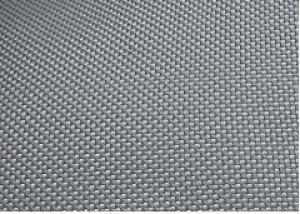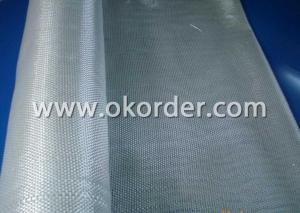High Strength Fiberglass Fabrics Woven Roving at Good Price
- Loading Port:
- Shanghai
- Payment Terms:
- TT OR LC
- Min Order Qty:
- 1 m.t.
- Supply Capability:
- 100 m.t./month
OKorder Service Pledge
OKorder Financial Service
You Might Also Like
Fiberglass woven roving Woven roving is a bidirectional fabric made by roving in plain weave pattern. The construction impants to the fabric an excellent dimensional stability during handling. Woven roving is a high-performance reinforcement and widely used in hand and machine production, such as boats, vessels, planes and automotive parts, furniture and sports facilities, and other fields.
plain weave, uniformity of thickness and low fuzz
fast and wet-out in resins
high mechanical strength and strength losses little in the humid environment.
Woven Roving | |||||||||
Specification | Tex | Fiber diameter(μm) | Count of cloth(end/cm) | Unit area mass(g/m2) | Weave pattern | ||||
Warp yarn | Weft yarn | Warp yarn | Weft yarn | Warp yarn | Weft yarn | ||||
EWR200 | 180 | 180 | 11 | 11 | 6.0 | 5.0 | 200±15 | plain | |
EWR300 | 400 | 400 | 13 | 13 | 4.0 | 3.5 | 300±30 | plain | |
EWR400 | 480 | 500 | 13 | 13 | 4.0 | 3.8 | 385±30 | plain | |
EWR600 | 1300 | 960 | 13 | 13 | 2.6 | 2.6 | 600±45 | plain | |
EWR800 | 2200 | 1760 | 13 | 13 | 2.0 | 2.0 | 810±40 | plain | |
Remark: The above data are only the representative products, different specifications are available as per customers’ requirements
- Q: How does fiberglass fabric perform in cryogenic applications?
- Fiberglass fabric exhibits exceptional performance in cryogenic applications thanks to its unique properties. The impact of cryogenic temperatures on materials can be significant, but fiberglass fabric stands out with its excellent thermal insulation and low thermal conductivity, making it an ideal choice for use in cryogenic environments. One of the main advantages of fiberglass fabric in cryogenic applications lies in its ability to withstand extremely low temperatures without compromising its structural integrity. It possesses a high melting point and can endure thermal stress, ensuring its durability and reliability even under harsh conditions. This makes fiberglass fabric suitable for applications such as cryogenic storage tanks, pipelines, and equipment handling liquefied gases including nitrogen, oxygen, and LNG (Liquefied Natural Gas). Furthermore, fiberglass fabric demonstrates minimal thermal expansion, meaning it remains relatively stable when exposed to extreme temperature changes. This property is crucial in cryogenic applications as it helps prevent leaks or cracks that could compromise the system's integrity. Moreover, fiberglass fabric is non-corrosive and resistant to chemicals, which makes it suitable for use in cryogenic environments where exposure to potentially corrosive substances is common. It exhibits little to no reaction with most cryogenic fluids, ensuring the fabric remains intact and does not degrade over time. Another significant aspect is fiberglass fabric's excellent electrical insulation properties. Given that cryogenic applications often involve the handling of electrical components, utilizing fiberglass fabric as an insulating material helps prevent issues related to electrical conductivity that may arise due to temperature fluctuations. Overall, fiberglass fabric excels in cryogenic applications due to its thermal insulation, low thermal conductivity, high melting point, minimal thermal expansion, chemical resistance, and electrical insulation properties. These characteristics make it a reliable and durable material for various cryogenic systems and equipment.
- Q: Is fiberglass fabric suitable for making outdoor cushions?
- Indeed, outdoor cushions can be crafted with fiberglass fabric, which is renowned for its durability, strength, and ability to withstand diverse weather conditions. This fabric proves to be a fitting selection for outdoor purposes as it resists fading, UV rays, and mold, which are prevalent concerns for outdoor cushions. Moreover, fiberglass fabric often possesses water-resistant or water-repellent properties, rendering it ideal for outdoor use where cushions may encounter rain or other forms of moisture. Ultimately, fiberglass fabric provides a dependable and enduring choice for outdoor cushions, guaranteeing their ability to withstand the elements and uphold their superior quality throughout time.
- Q: Is fiberglass fabric resistant to chemicals used in water treatment?
- Yes, fiberglass fabric is generally resistant to chemicals used in water treatment.
- Q: Can fiberglass fabric be used for making insulation tapes?
- Insulation tapes can indeed be made using fiberglass fabric. Opting for fiberglass fabric when manufacturing insulation tapes is a wise decision due to its exceptional thermal insulation characteristics. This material exhibits remarkable resistance to high temperatures and can withstand extreme heat, rendering it ideal for situations where insulation is imperative. Moreover, fiberglass fabric also possesses resistance against chemicals, moisture, and fire, thereby further augmenting its suitability for insulation tapes. Its sturdy and durable nature guarantees the ability to endure wear and tear, establishing it as a dependable choice for long-lasting insulation tapes. In summary, fiberglass fabric is an excellent material for producing insulation tapes due to its thermal insulation attributes, heat and chemical resistance, as well as its durability.
- Q: Are fiberglass fabrics resistant to mildew or fungus?
- Fiberglass fabrics have a tendency to resist mildew or fungus in most cases. This is because fiberglass, being a non-porous material, does not create an ideal environment for the growth of mold, mildew, or fungus. Furthermore, special coatings or finishes are frequently applied to fiberglass fabrics to further enhance their resistance against these types of organisms. However, it is worth noting that although fiberglass fabrics generally repel mildew or fungus, they are not entirely immune. In instances where the fabric is excessively exposed to moisture or not adequately maintained, there is still a possibility for mildew or fungus to develop. Hence, it is advisable to adhere to proper cleaning and maintenance protocols when dealing with fiberglass fabrics to guarantee their durability and prevent any potential growth of mold or mildew.
- Q: Can fiberglass fabrics be used for insulation in pipelines?
- Yes, fiberglass fabrics can be used for insulation in pipelines. Fiberglass fabrics have excellent thermal insulating properties as they can effectively prevent heat transfer. When used as insulation in pipelines, fiberglass fabrics can help to maintain the desired temperature of the fluid being transported, whether it is hot or cold. Additionally, fiberglass fabrics are resistant to moisture and chemicals, which makes them suitable for use in various environments. They are also lightweight and flexible, allowing for easy installation and maintenance. Overall, fiberglass fabrics are a popular choice for pipeline insulation due to their thermal insulation capabilities and durability.
- Q: How to identify the warp and weft direction of glass fiber cloth?
- If the double or double weft fabric in glass fiber, if double root lines appear in the sample in parallel to the neat words as if there is a superposition of warp, weft
- Q: Does fiberglass fabric have any health hazards?
- Fiberglass fabric can pose health hazards if proper safety precautions are not taken during handling and installation. The tiny fibers can become airborne and easily inhaled, leading to respiratory issues and irritation. However, if appropriate safety measures such as wearing protective clothing and using respiratory protection are followed, the health risks associated with fiberglass fabric can be minimized.
- Q: How does fiberglass fabric handle abrasion in mining operations?
- Due to its outstanding durability and resistance to wear and tear, fiberglass fabric is a superior option for managing abrasion in mining operations. In the harsh conditions commonly found in mining, where abrasive materials like rocks, stones, and minerals are frequently encountered, fiberglass fabric withstands the test. The high tensile strength of fiberglass fabric is one of its key properties, allowing it to endure constant rubbing and scraping against abrasive surfaces. The tightly woven structure of the fabric acts as a protective shield, preventing abrasive particles from penetrating and causing damage. Furthermore, fiberglass fabric exhibits remarkable resistance to chemical corrosion, a common occurrence in mining environments. It can endure exposure to acids, alkalis, and other corrosive substances commonly found in mining operations. This resistance guarantees that the fabric remains intact and functional even in the presence of harsh chemicals, thus enhancing its durability against abrasion. Moreover, fiberglass fabric possesses excellent heat resistance, making it suitable for mining operations involving high temperatures. It can withstand extreme heat conditions without compromising its structural integrity or performance. This characteristic is particularly essential in operations such as smelting, which involve intense heat. Additionally, fiberglass fabric is lightweight and flexible, making it easy to handle and install in mining equipment. Its flexibility allows it to conform to irregular shapes and surfaces, ensuring a secure fit and maximum protection against abrasion. To summarize, fiberglass fabric is an ideal choice for handling abrasion in mining operations due to its exceptional durability, resistance to wear and tear, chemical corrosion resistance, and heat resistance. Its high tensile strength, flexibility, and lightweight nature make it a reliable and practical solution for safeguarding mining equipment and machinery from the abrasive forces encountered in these operations.
- Q: What is the typical warp and weft count of fiberglass fabrics?
- The typical warp and weft count of fiberglass fabrics can vary depending on the specific application and desired characteristics. However, it is common to find fiberglass fabrics with a warp count ranging from 10 to 20 ends per inch and a weft count ranging from 10 to 20 picks per inch.
Send your message to us
High Strength Fiberglass Fabrics Woven Roving at Good Price
- Loading Port:
- Shanghai
- Payment Terms:
- TT OR LC
- Min Order Qty:
- 1 m.t.
- Supply Capability:
- 100 m.t./month
OKorder Service Pledge
OKorder Financial Service
Similar products
Hot products
Hot Searches
Related keywords
























